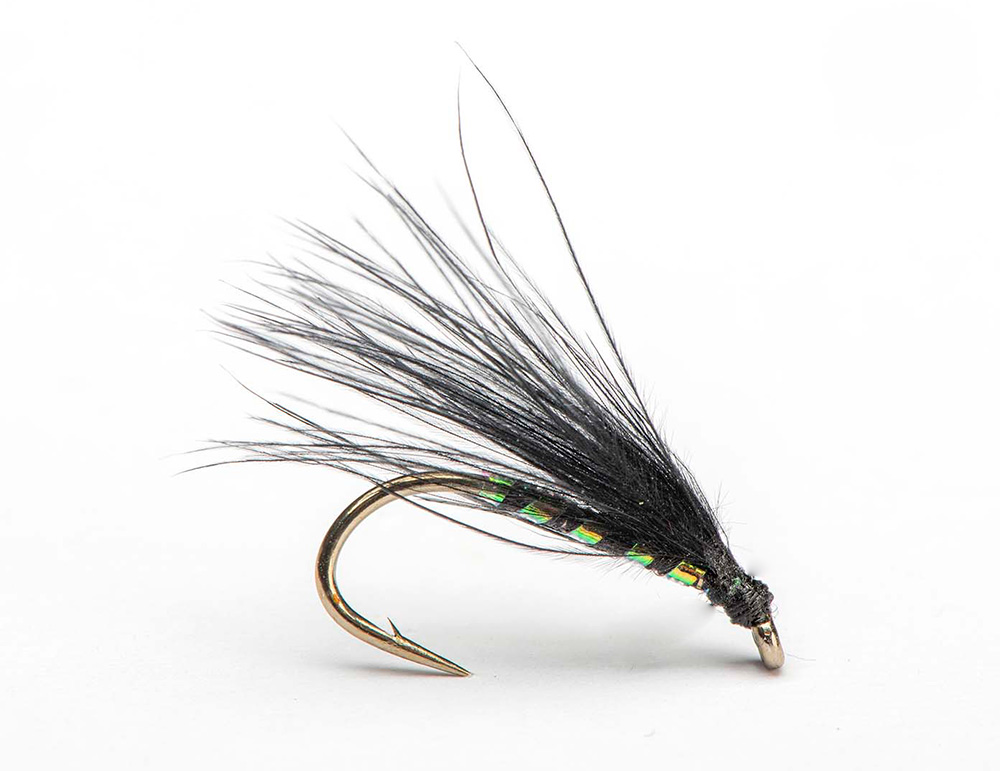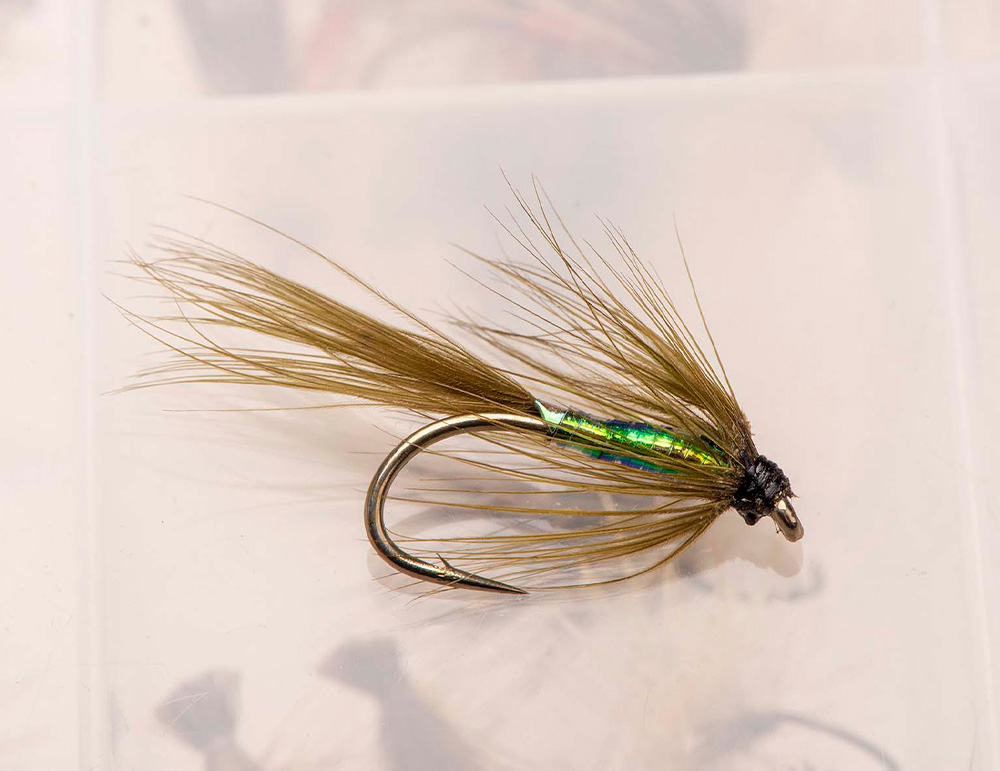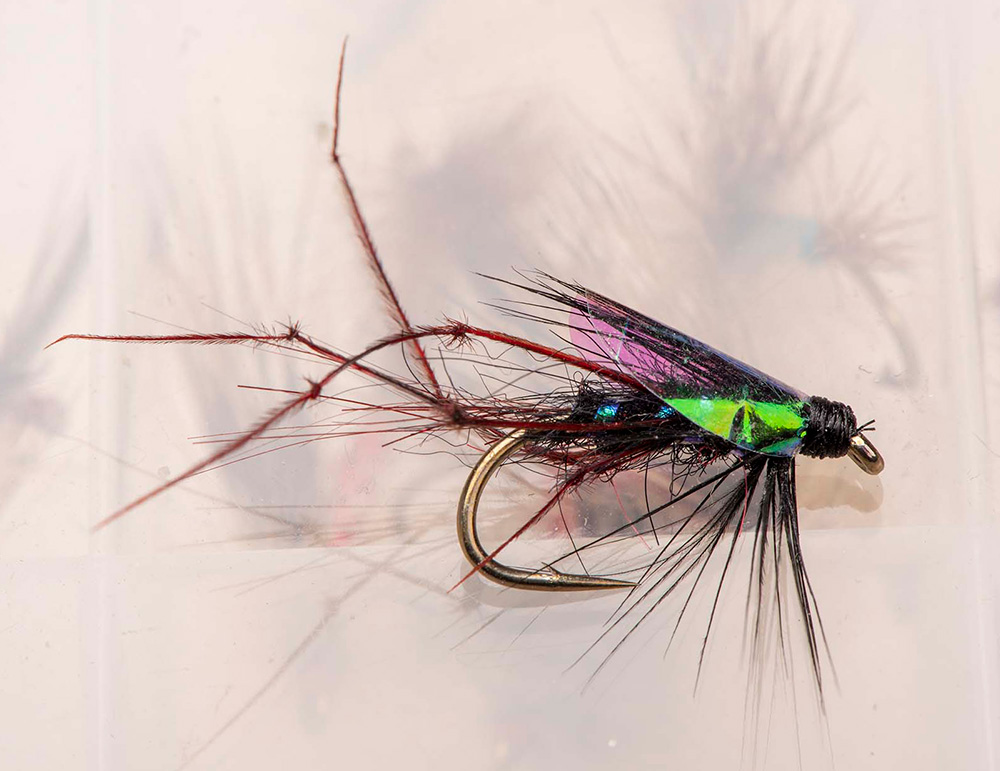Ronald Orr lists three summer patterns tied with Mylar – the reflective, metallicised plastic – as a key component of the dressing.
Skinny Mylar Cormorant
 Hook: Standard wet fly, sizes 10 and 12.
Hook: Standard wet fly, sizes 10 and 12.
Thread: Black.
Body: Built-up thread, or black floss.
Rib: Non-stretch Mylar stretched to the point of breaking and a change of hue (pinkish to blue-green).
Wing: Black marabou.
Grasshopper became the Master! On Tuesday evenings at the Lake of Menteith, myself and other qualified coaches teach youngsters for free, and their boat hire is heavily subsidised by the Lake’s management.
Whilst I hold many cups and trophies year on year within my own club, nothing beats the thrill and excitement of helping a youngster catch his first fish. Every fisherman I know remembers his first fish, and it is a pleasure to be part of such an event.
After that momentous event we then try and hone the youngsters’ skills. We obviously do a good job, because earlier this year one youth turned the tables on me and caught far more trout than I did; to the point of embarrassment. Let’s just say he caught loads on a Cormorant, but the one he’d tied that was a little bit special, with a stretched Mylar rib.
I have Cormorants of every colour, hue and variation: however this one – the first of the three summer patterns tied with Mylar – is outstanding, and easy to tie, even for beginners. You can actually tie it with just two materials – black marabou and #14 (1/32nd) pearl Mylar – plus your black thread, although I like to bulk up the body a little with black salmon floss. (See our tying tips here)

The Mylar used for the Skinny Cormorant is 1/16 in. pearl Mylar which is then stretched before tying in. Pull either end without breaking it, and a colour change will take effect – it takes on a blueish hue
The key to the tying is: firstly, it’s skinny; and secondly, the rib, which is pre-stretched before it is tied in. As you stretch the Mylar it takes on a different hue, which again changes as it is wound over a black body. You’ll see that Mylar is normally blueish with a pinky tinge, but when stretched hard (almost to the point of snapping) it will crinkle and take on a greenish hue. Note that this only works with a non-stretch Mylar. Stretchy Mylars will stretch and collapse into a thinner strand, but retain the same hue, without taking on the green (see photo).
Olive hackled Mylar Spider

Black Sili-leg under-body with Mylar over – a great body for Mayfly Nymphs
Hook: Size 10 or 12 wet fly.
Tail: Soft olive fibres from the base of an olive cock hackle.
Under-body: Black Sili-leg wound in close, touching turns up body.
Body: Over-wrap under-body with 3/32 in pearl Mylar (unstretched).
Hackle: Olive cock hackle.
There’s another Mylar-enhanced fly I’ve come across recently, which works well when Mayfly Nymphs are about. I came across it at the end of a National semi-final on the Lake, when the winner had caught far, far more than anyone else! He had been gifted three of these flies from another friend, who had also won his club’s competition a few days earlier. It was only because all three flies had been wrecked by the many sets of trout teeth that had attacked them that I was able to decipher the dressing, otherwise I would never have guessed that the Mylar body was wrapped over a wound black silicone Sili-leg!
For this reason, when tying for myself, I frequently wind the Mylar over a bed of wet varnish so it lasts that little bit longer on the end of my leader. Why change a fly that’s working! Even so, do not ever go out with just the two tyings of this fly. You may need more!
As I write, it’s exactly the right time of year for this fly. Mayfly nymphs abound, and during a short session yesterday on my local, private fishery it caught three of my five-fish bag on one over a short session.
Mylar-winged Heather Fly (Jim McBride)

Heather Fly, using a wing from a Mylar sheet cut to shape with a wing-punch
Hook: Down-eye dry fly, size 10-14.
Thread: Black.
Body: Black seal’s fur.
Rib: Pearl Mylar.
Legs: 6 pre-knotted cock pheasant tail fibres, dyed red.
Hackle: Black cock.
Wing: Punched-out Mylar sheet in a wing shape, ‘tented’ over body.
Some years ago I attended an inter-school Former Pupils competition on the Lake. I had the best catch, but the Heriot team, under the leadership of Colin Riach, had more fish to a man than the rest of us!
Later, in the pub, I got a good look at the Heather Fly that had done the “biz” for them. As Heather Flies go it was the usual thing: black dry fly Hopper-style with knotted red legs etc, but this one had two Mylar strips tied over as a wing; when fished dry they caught the light and glinted – a heliograph trigger-factor for the trout! This final of the three summer patterns tied with Mylar is exceptional.
I copied the fly and did well on it, but then took a tip from Jim McBride (Scottish internationalist, Craftye shop owner – now sadly closed). He used a wing-punch on sheet Mylar, folding it at 90 degrees into a roof-shape; this was even more effective again.
I used to go into Jim’s shop in Edinburgh and whilst there was always a good display of the ‘usual suspects’ of flies, but he also had an ‘under the counter’ selection of the flies that top rods were using at the time, hot off his vice. Business took me to Edinburgh often, and if time allowed, pleasure would take me into his shop. It was nicknamed the £20 shop… you walked in not needing anything in particular but always spent twenty pounds before you walked out again!
The height of this fly’s stature (for me!) came the following year, in the corresponding Former Pupils event, when my team (of just two anglers) caught a greater weight than all the four-man teams… and Glasgow High School’s first ever win since the competition’s inception in 1966! To cap it all, I took the individual trophy as well. I think this helps illustrate this fly’s effectiveness!
We haven’t had a good fall of heather fly for a few years now – perhaps one is now overdue for this summer? Fingers crossed. Flies tied.
Fishing for youngsters in the Stirling area is available through Lake of Menteith fishery manager, Quint Glen: 01877 385664.
Subscribe to Fly Fishing & Fly Tying for more great articles today.



